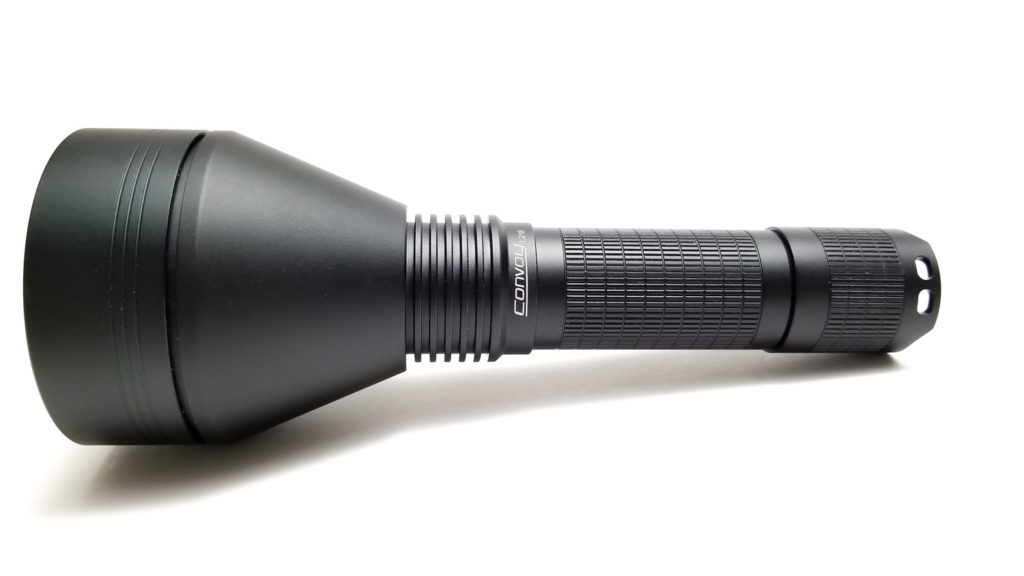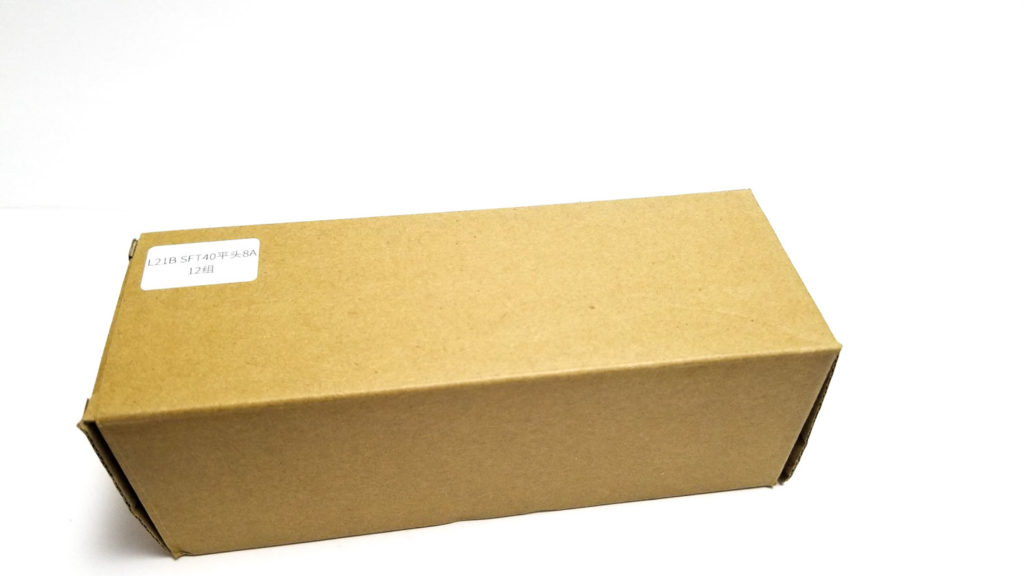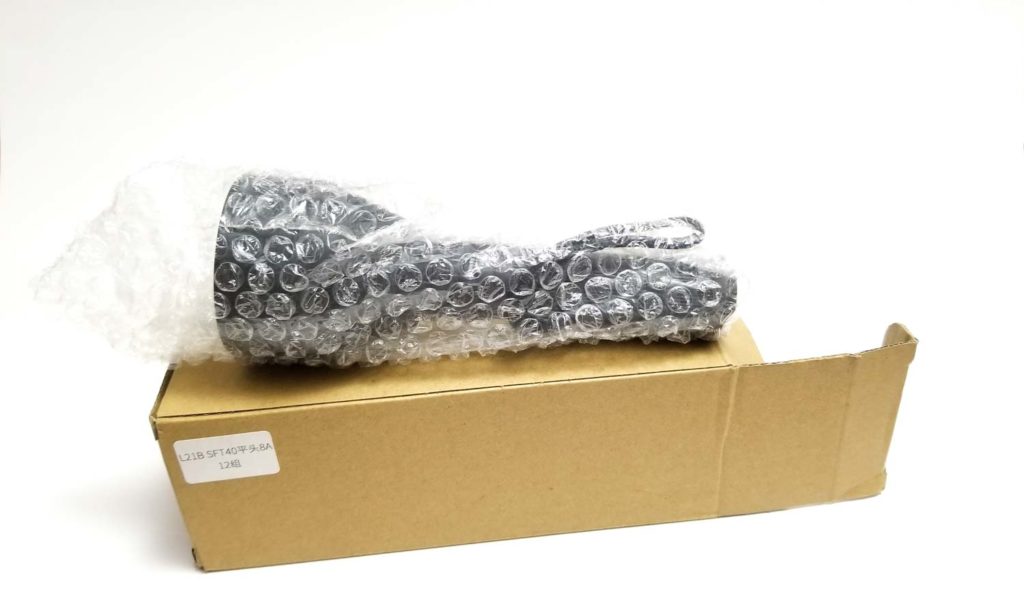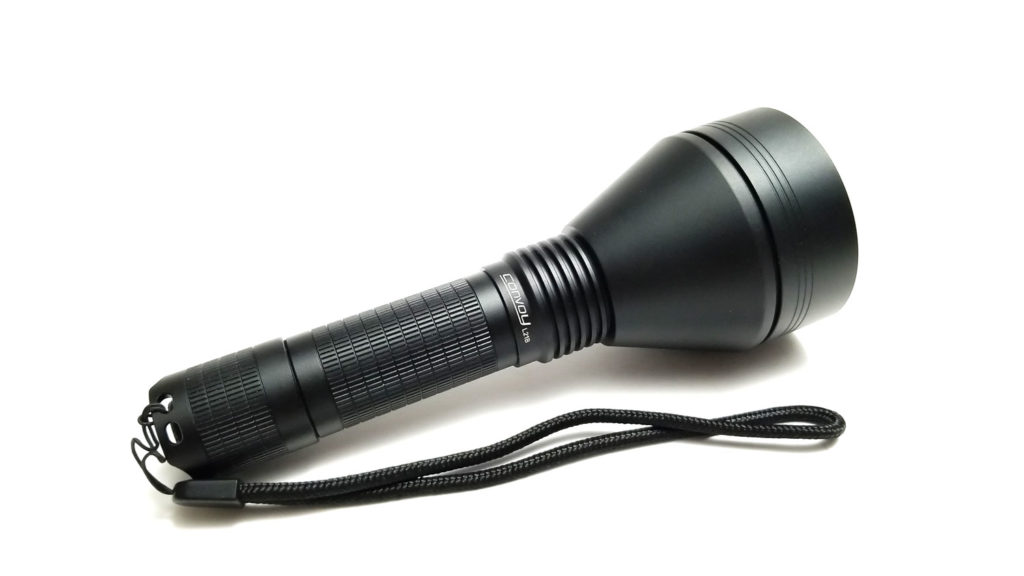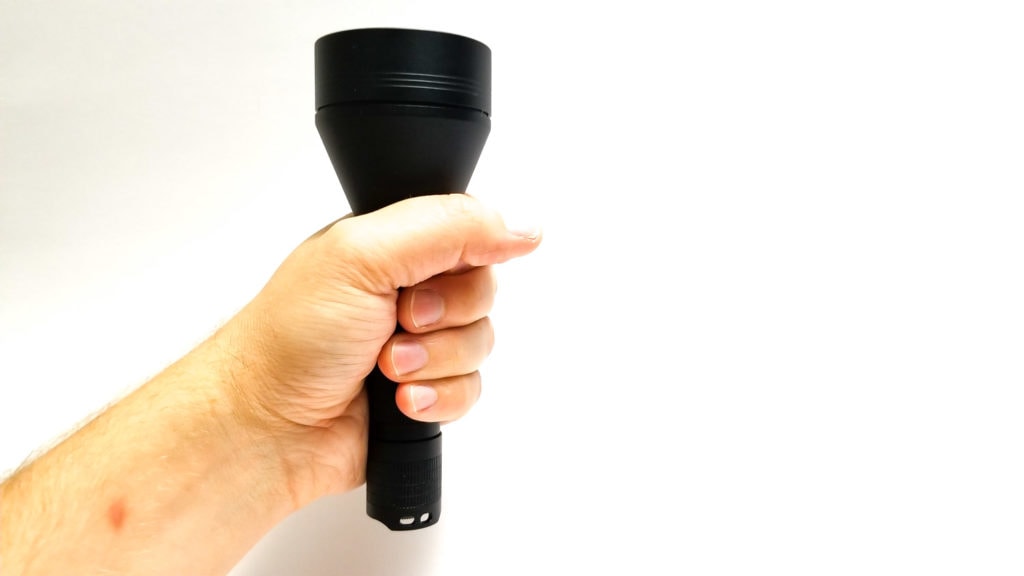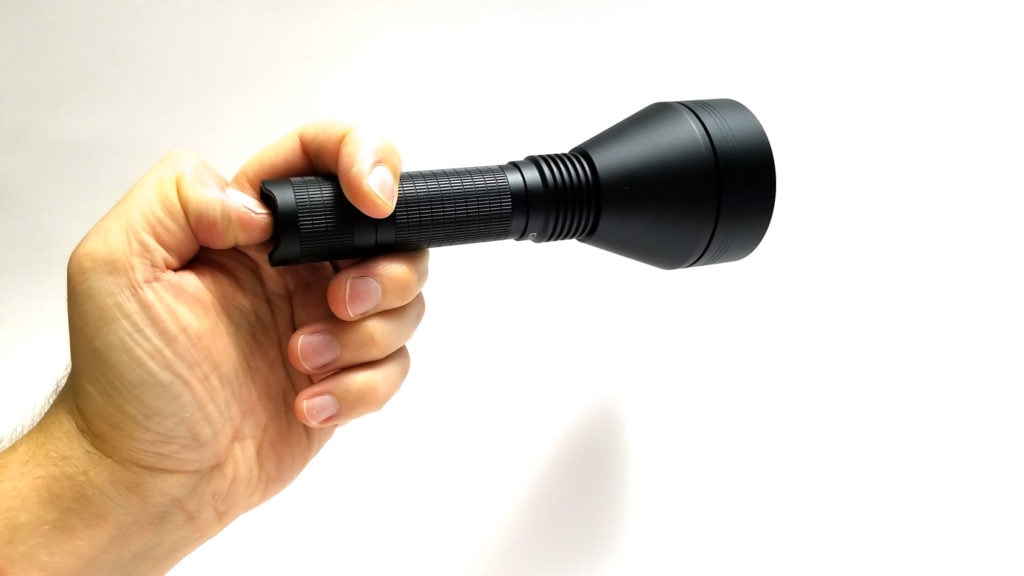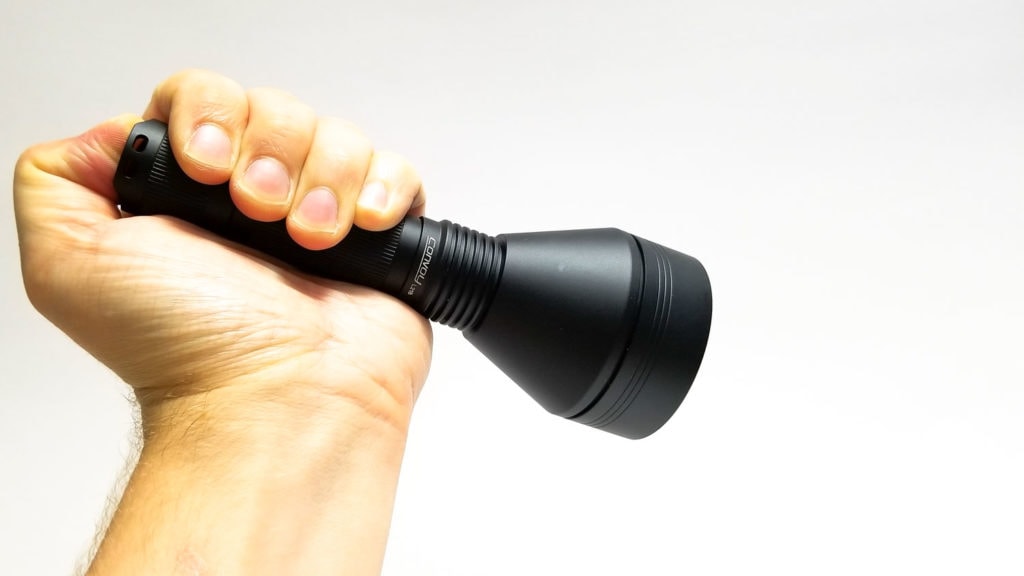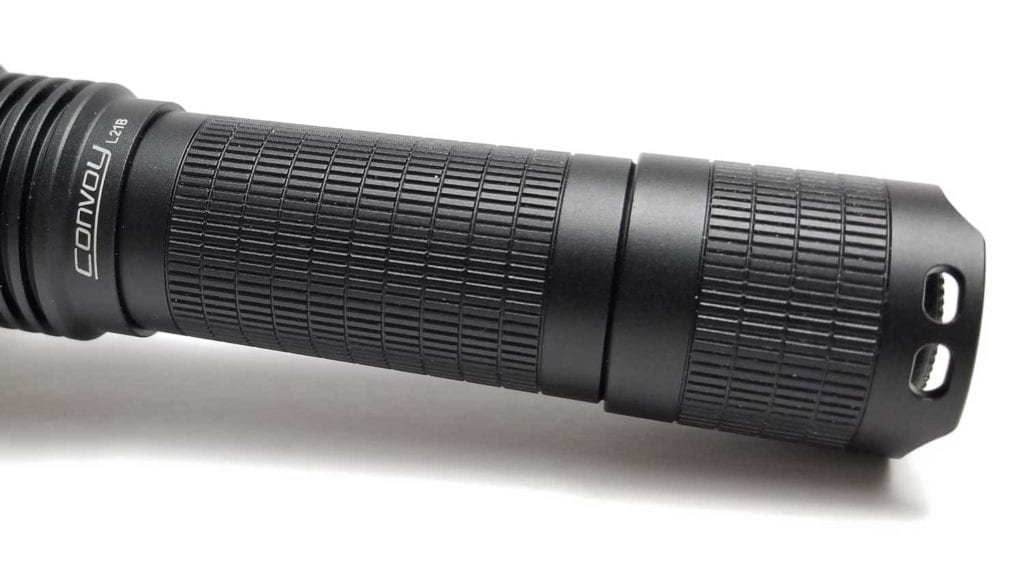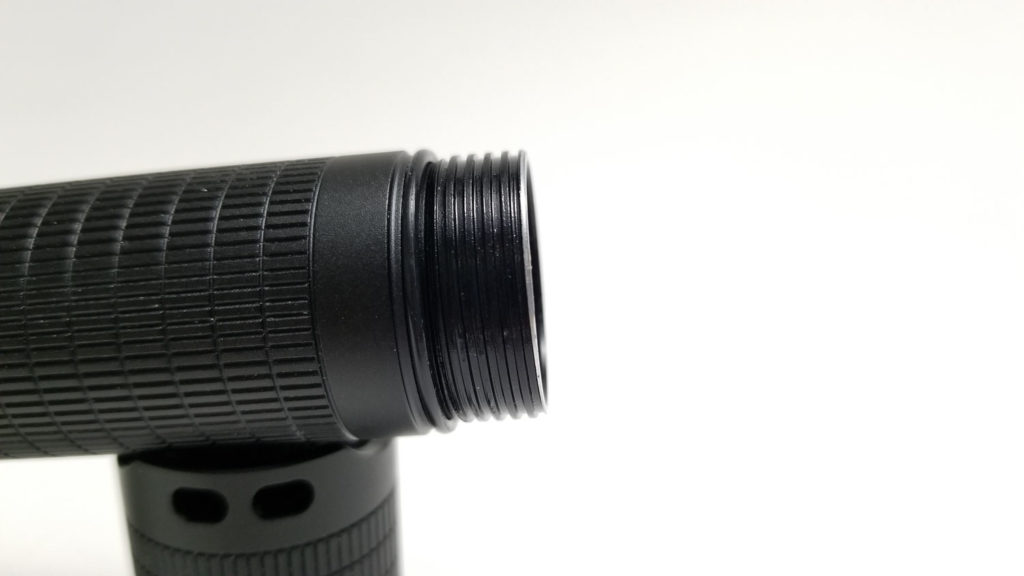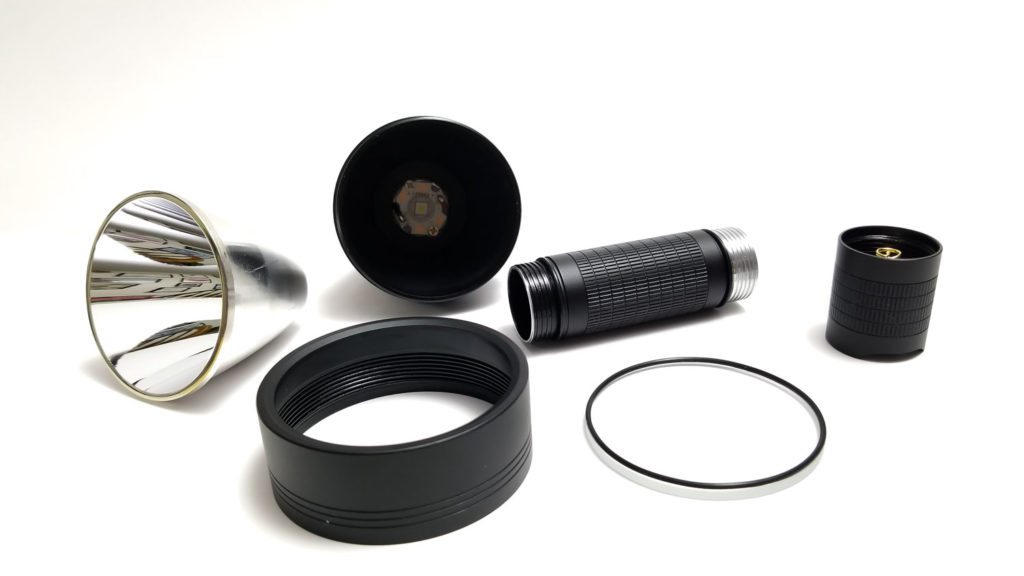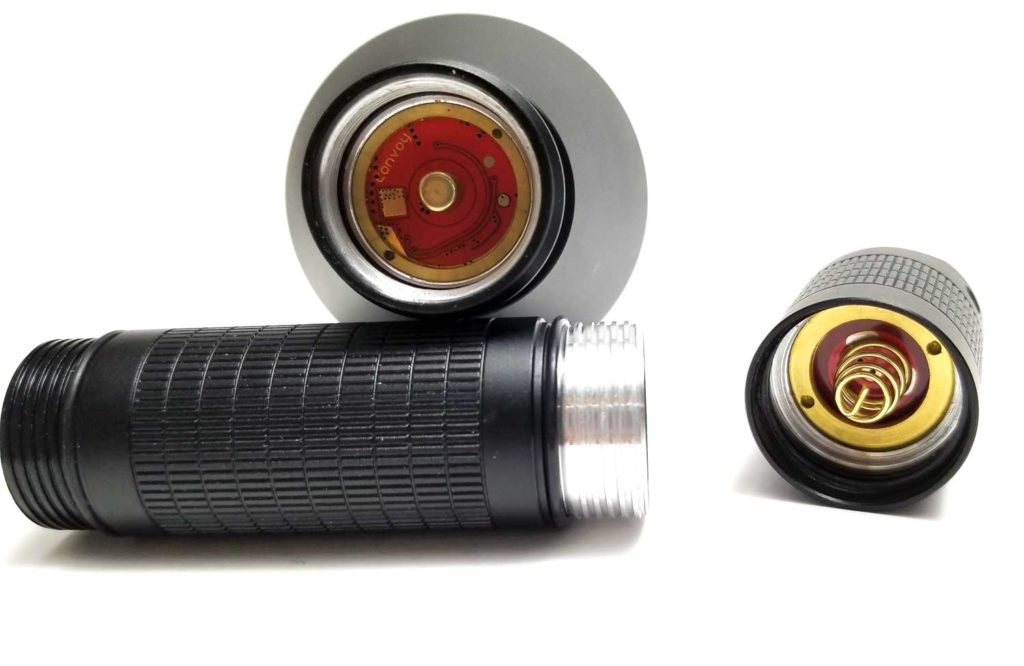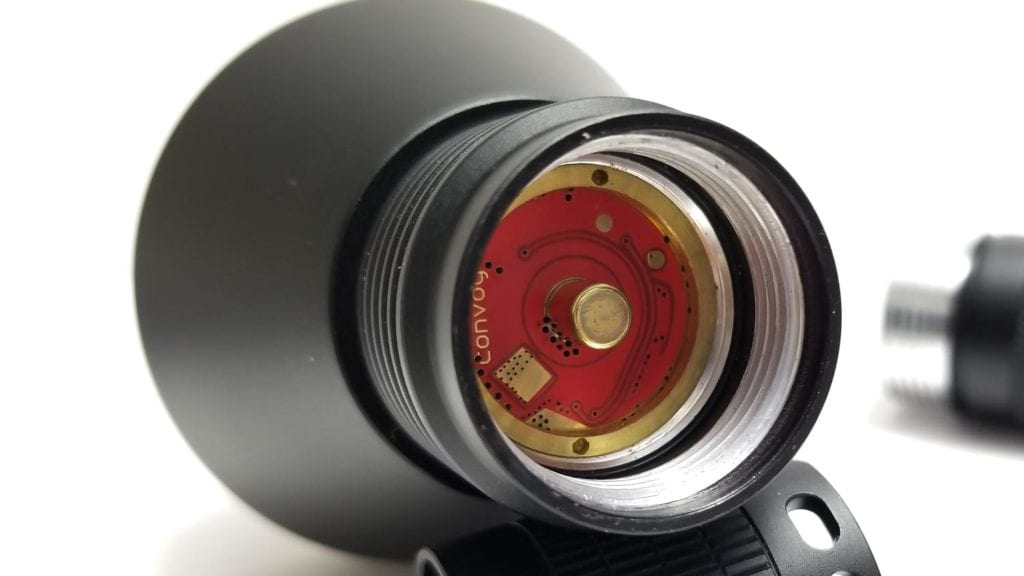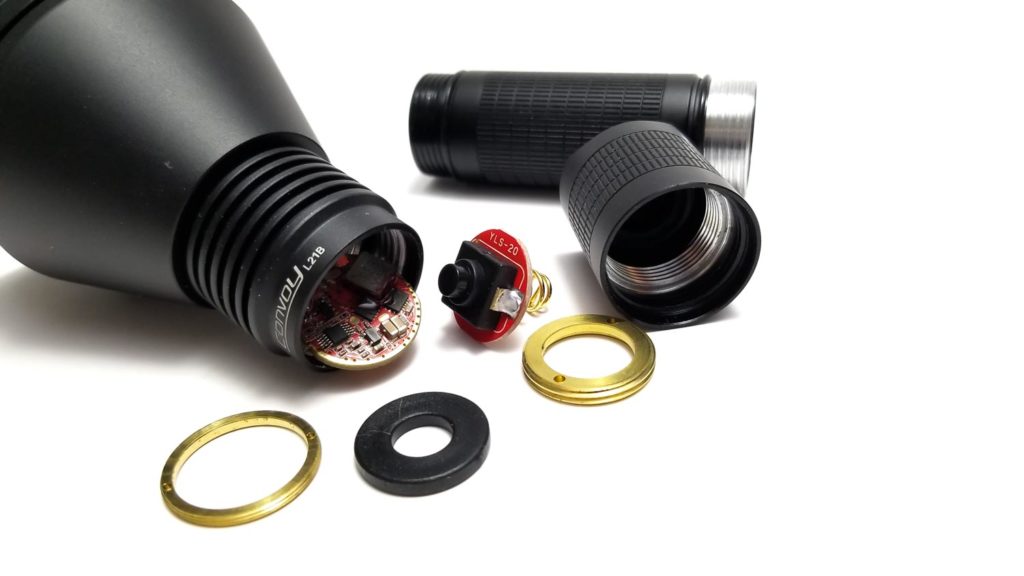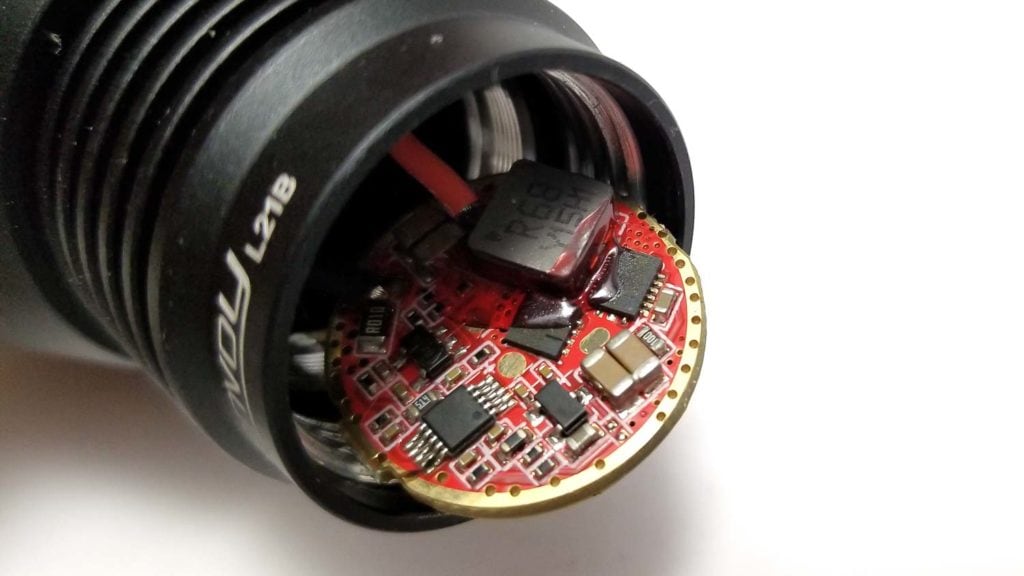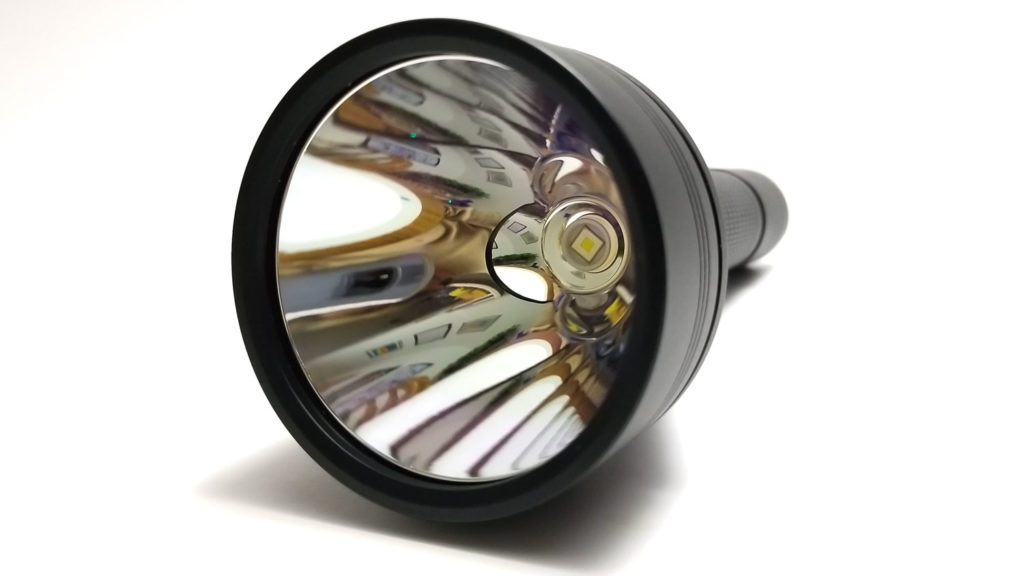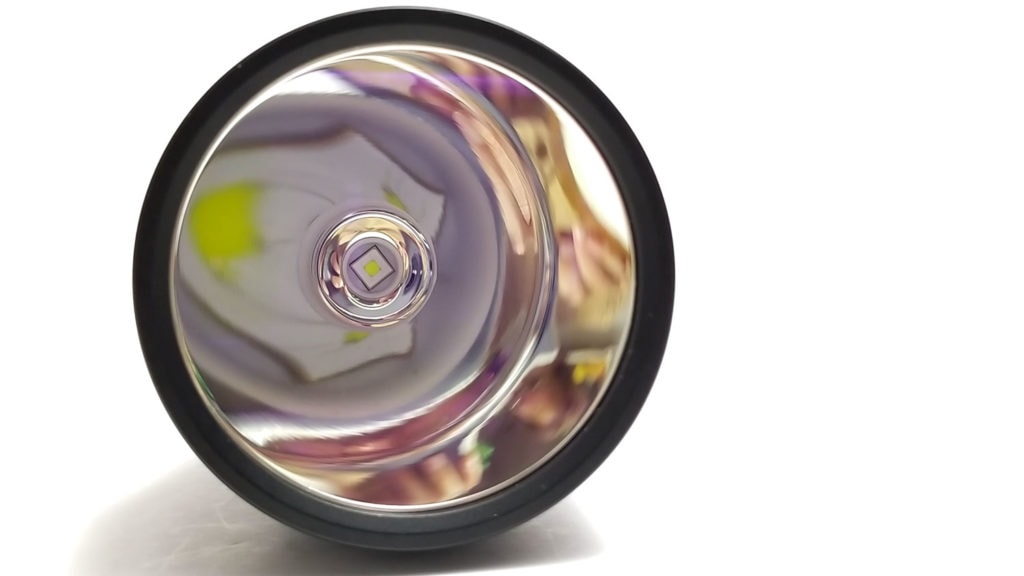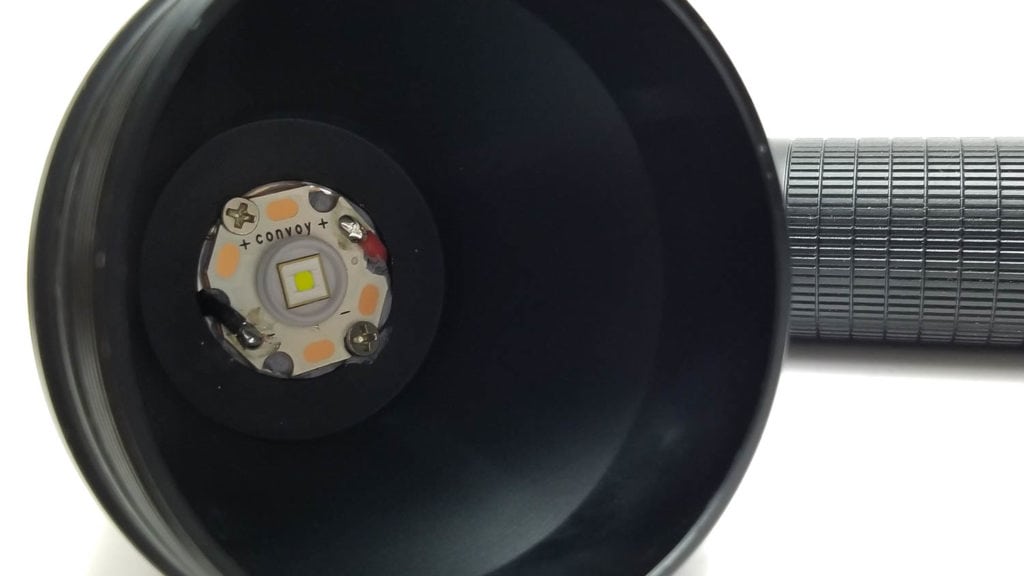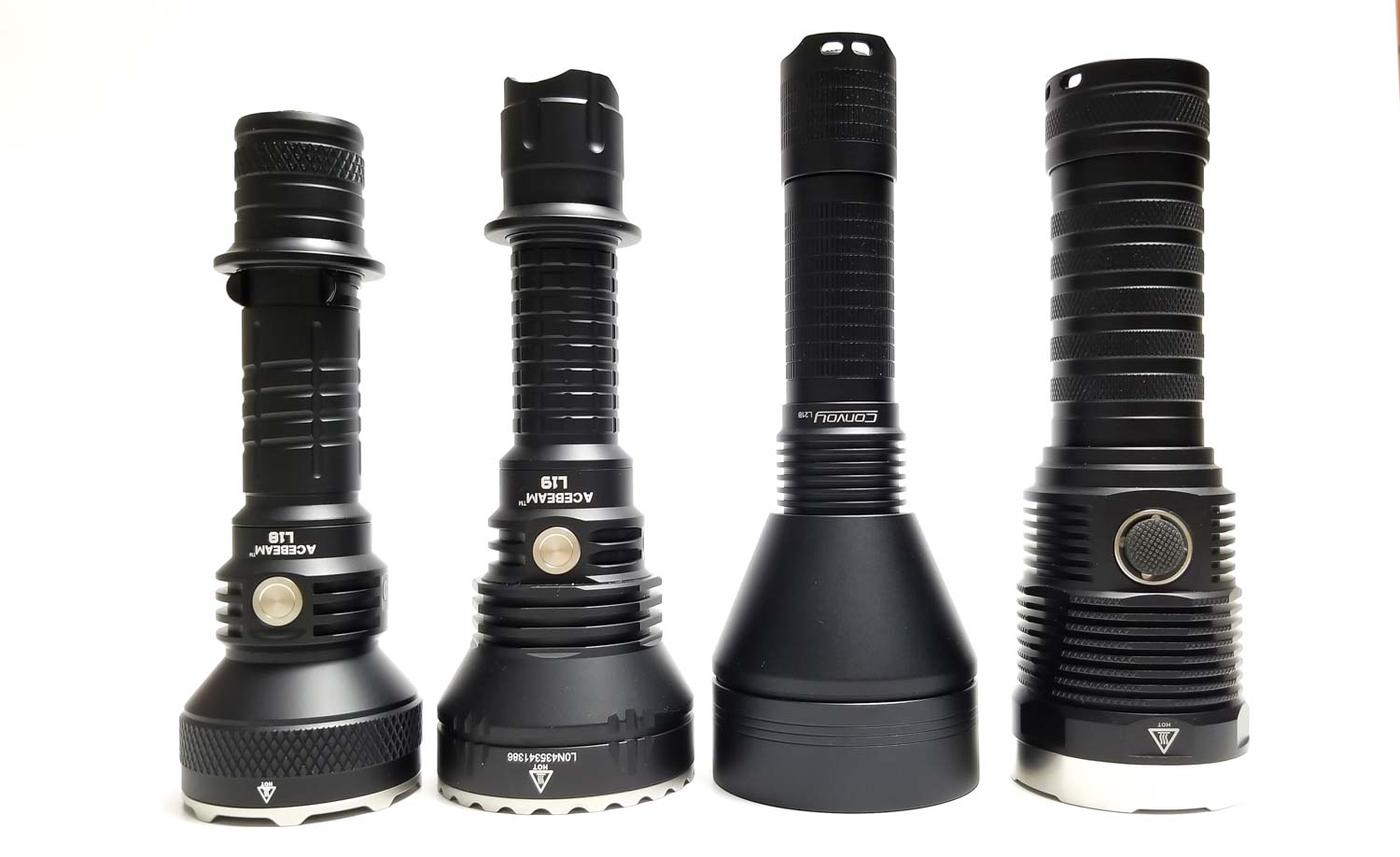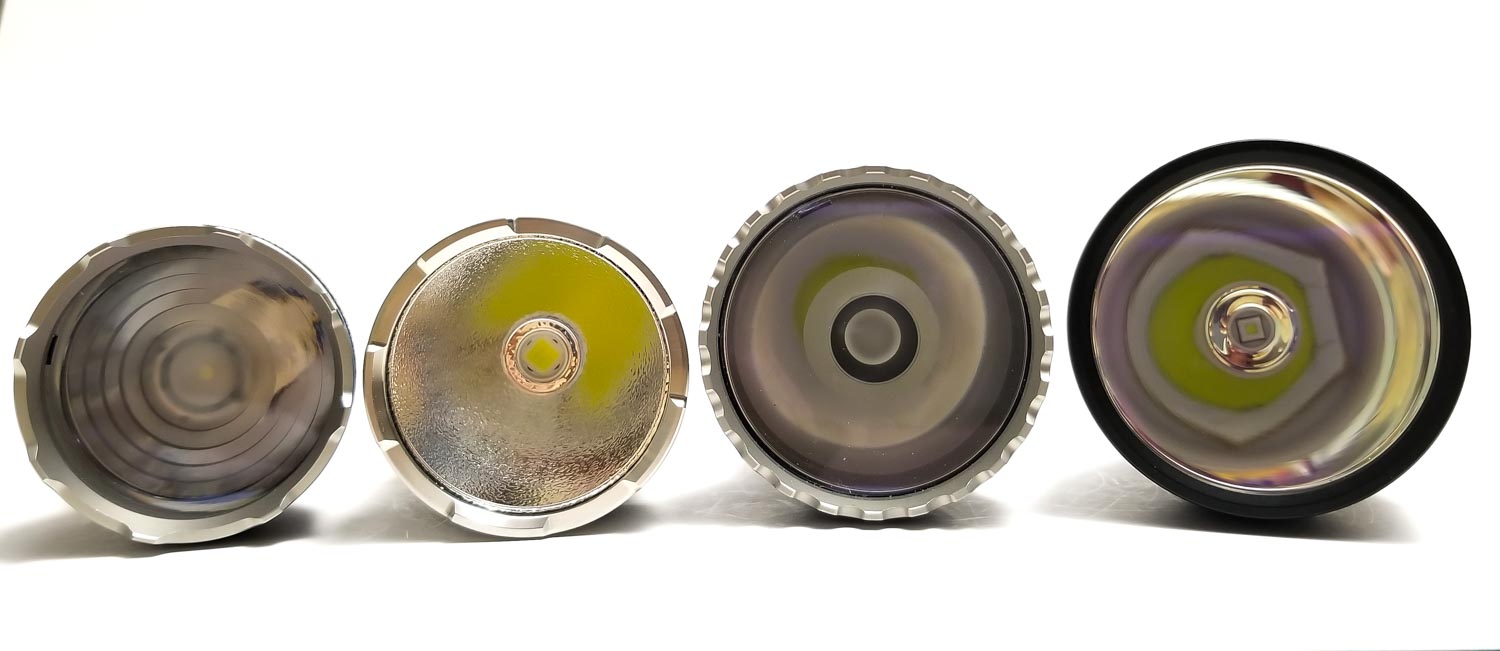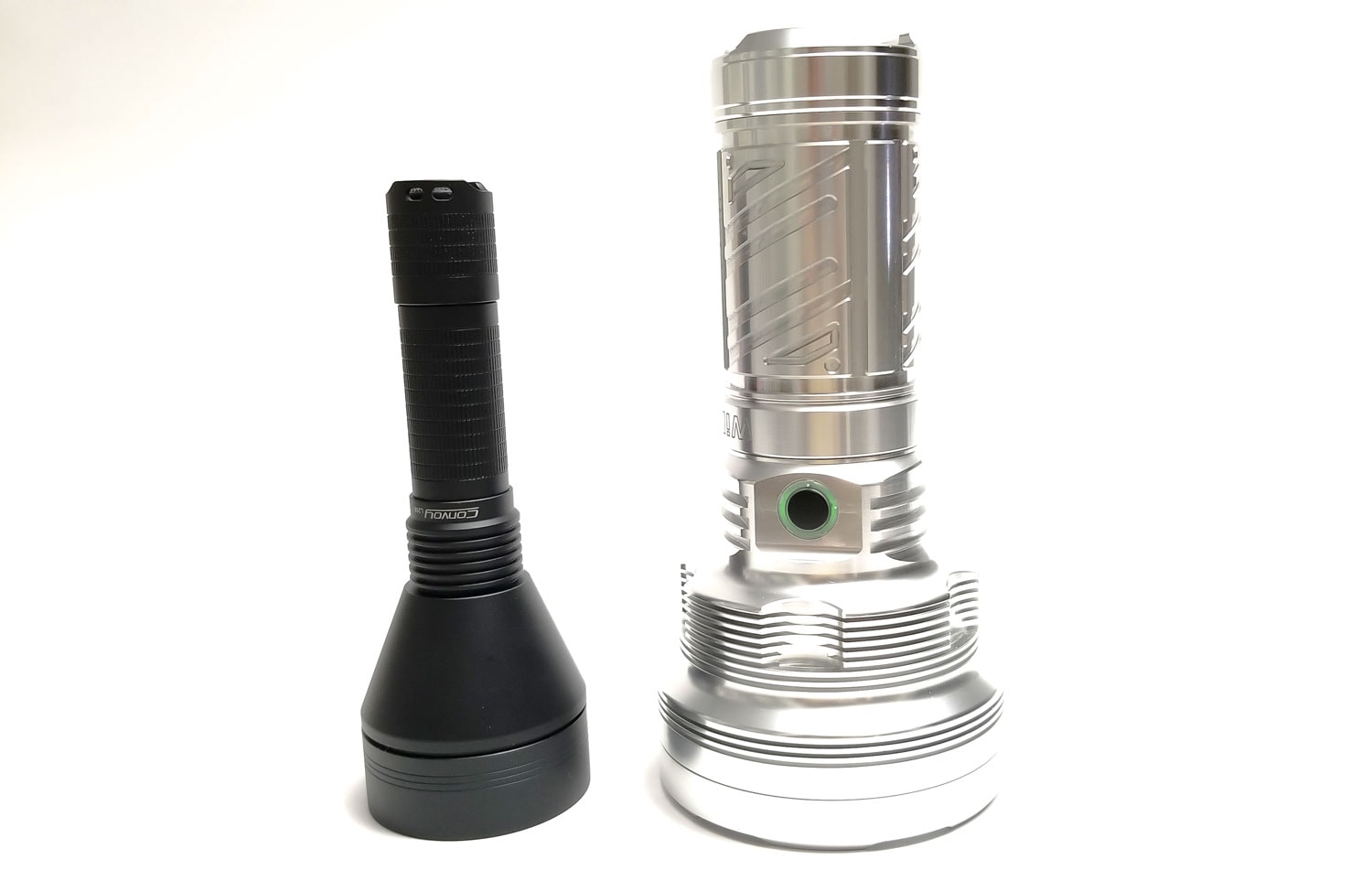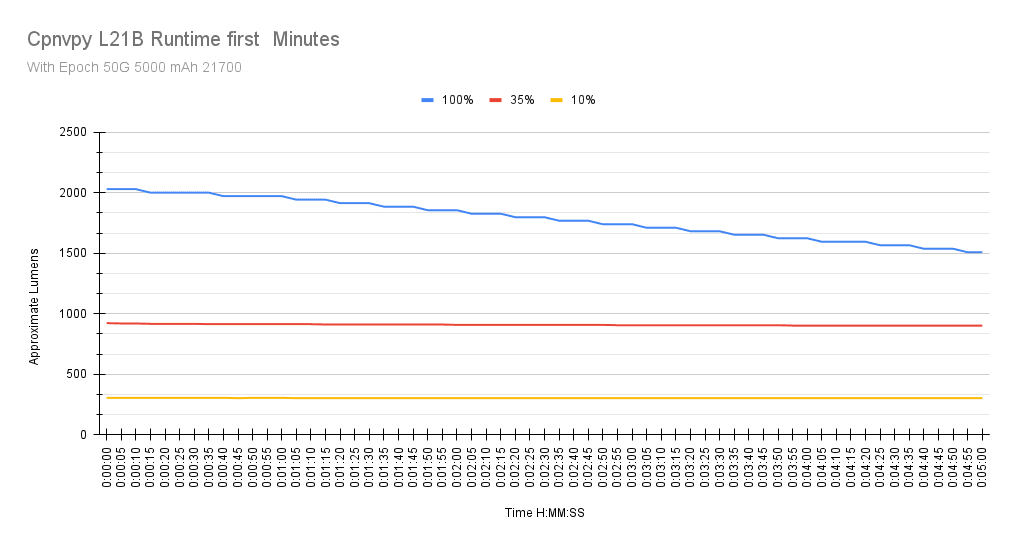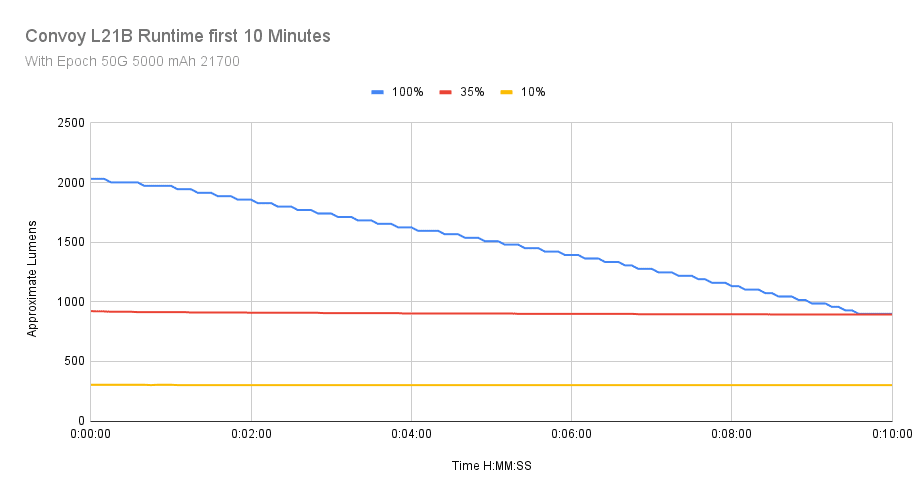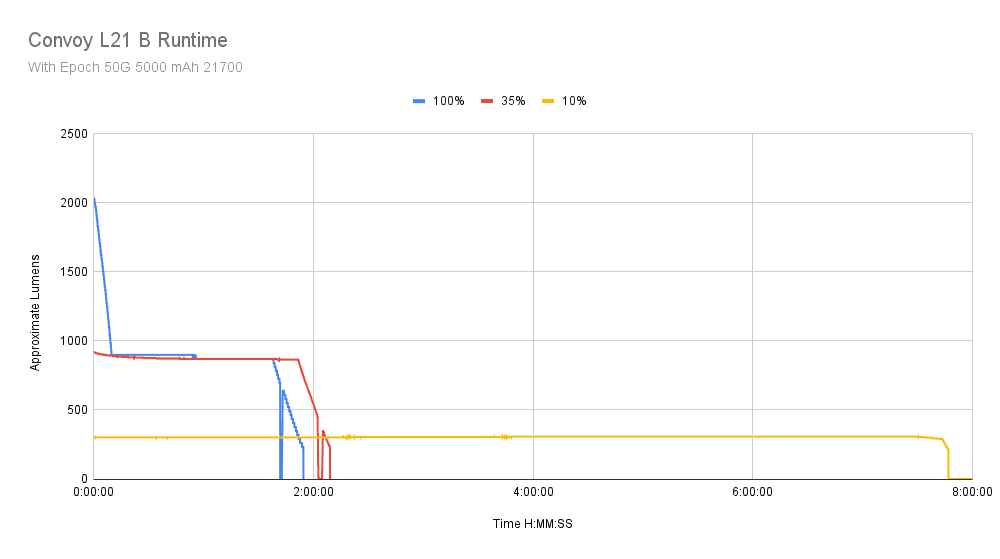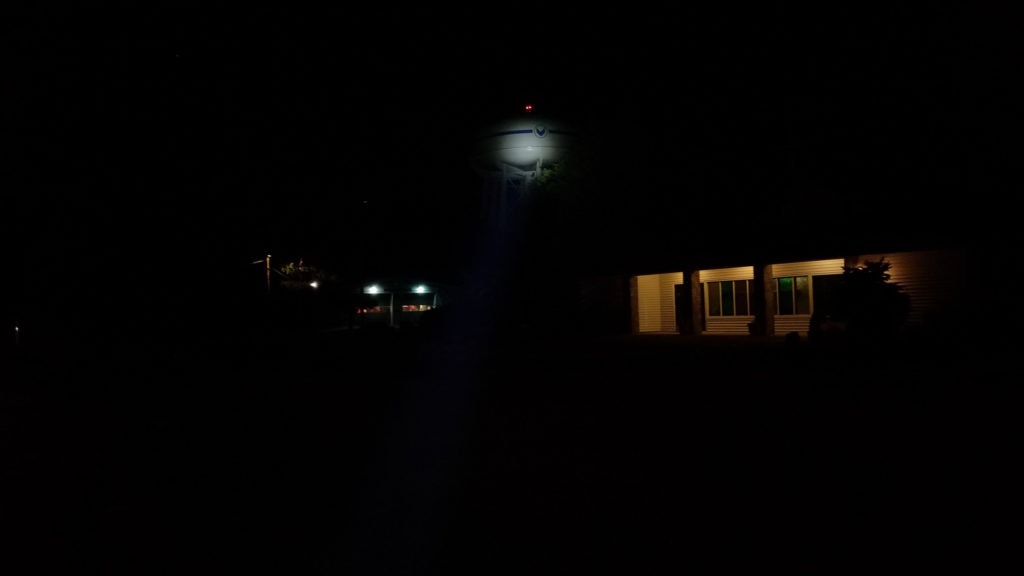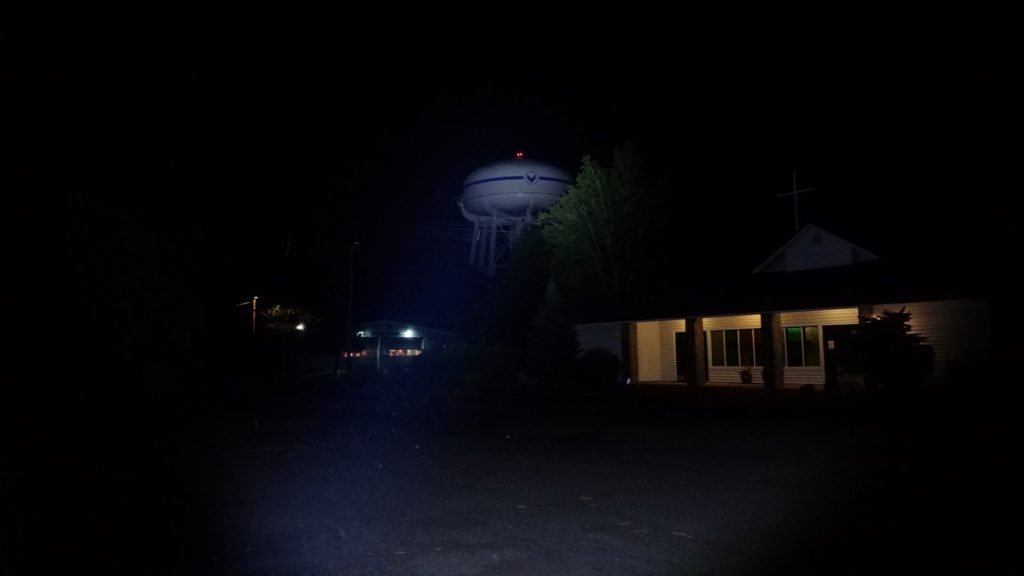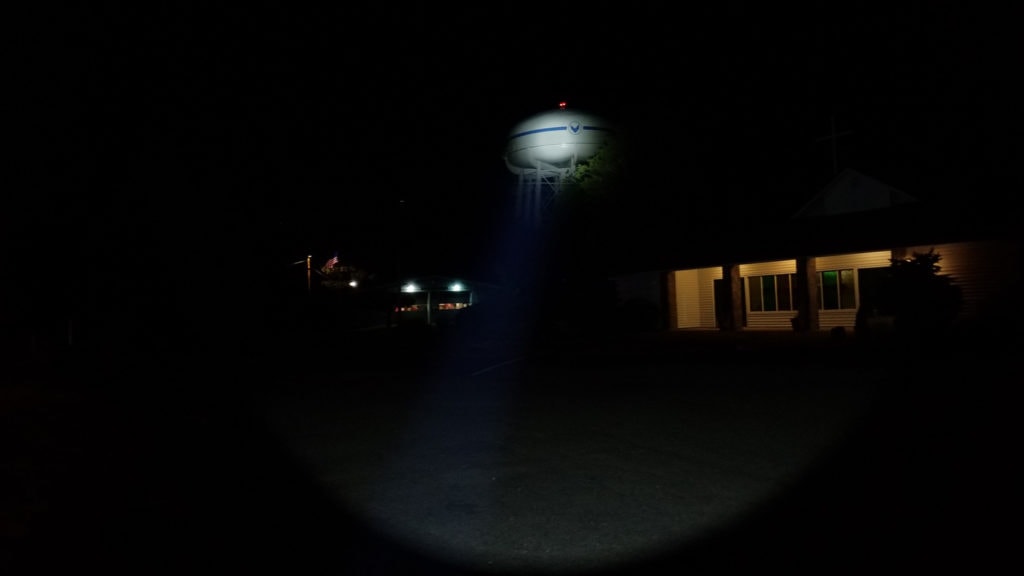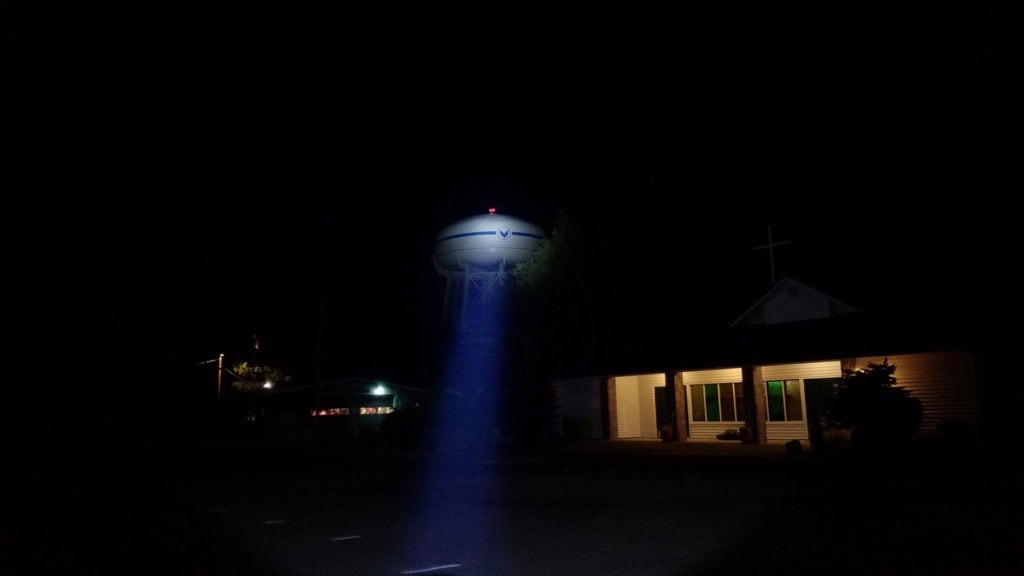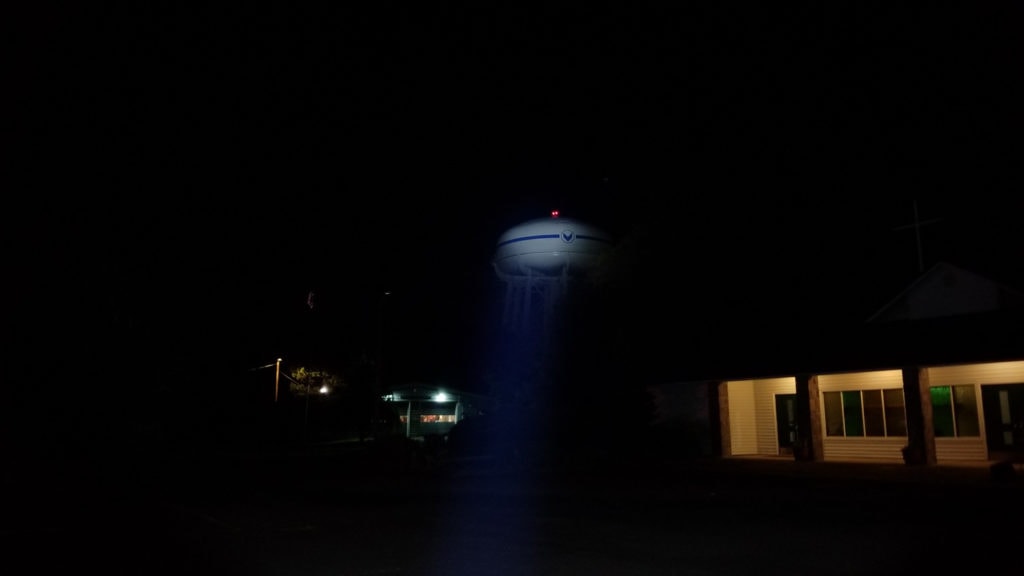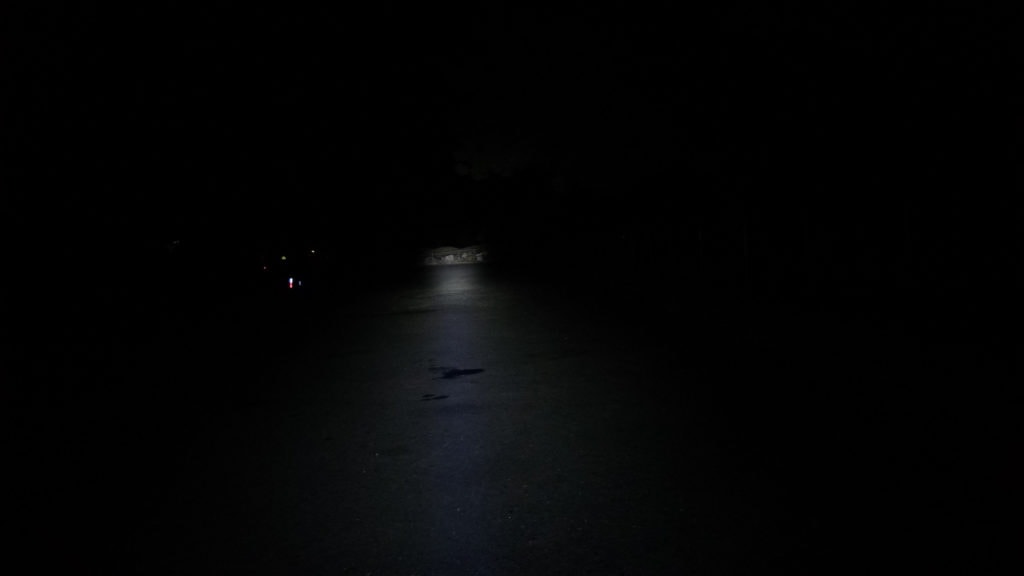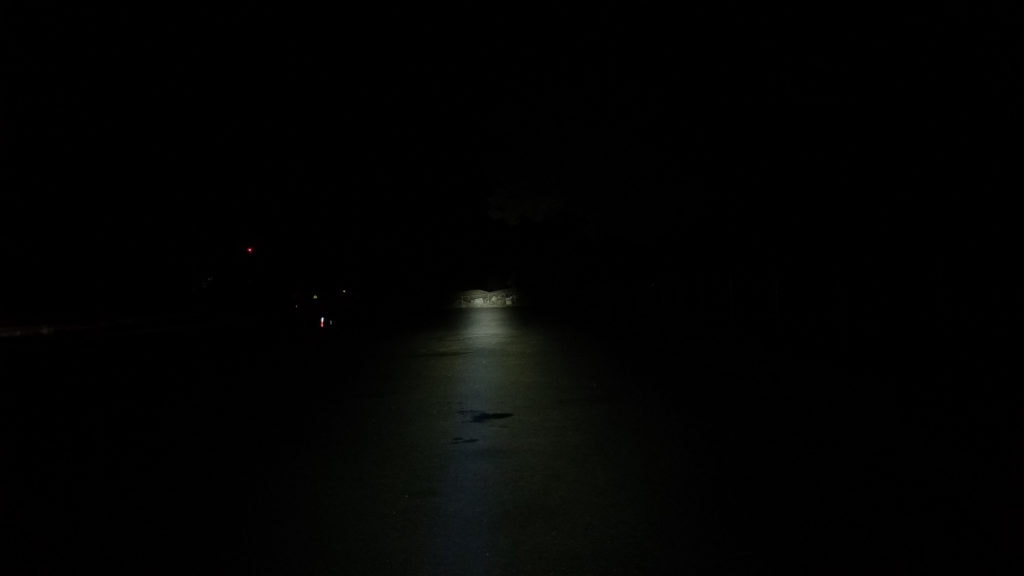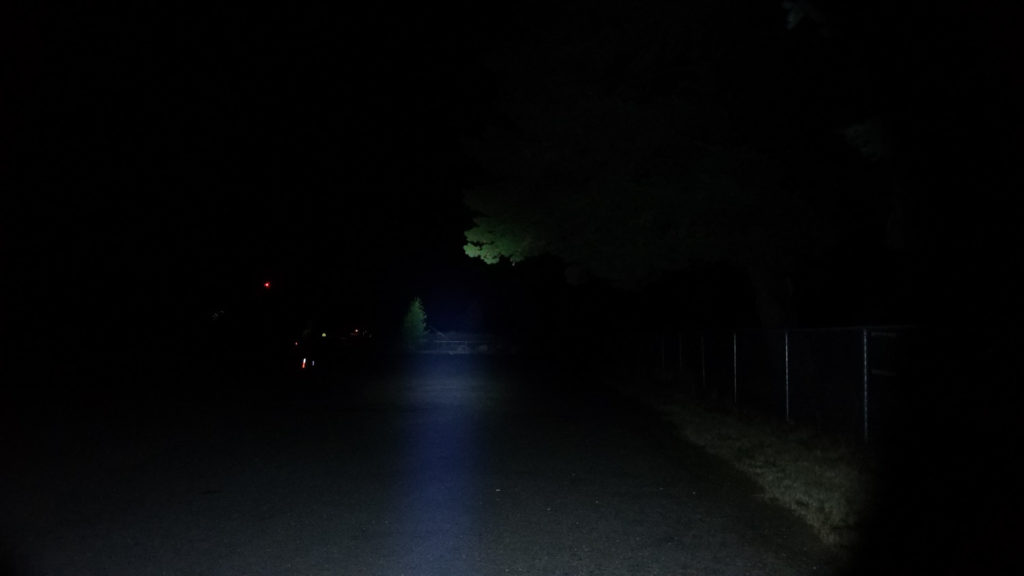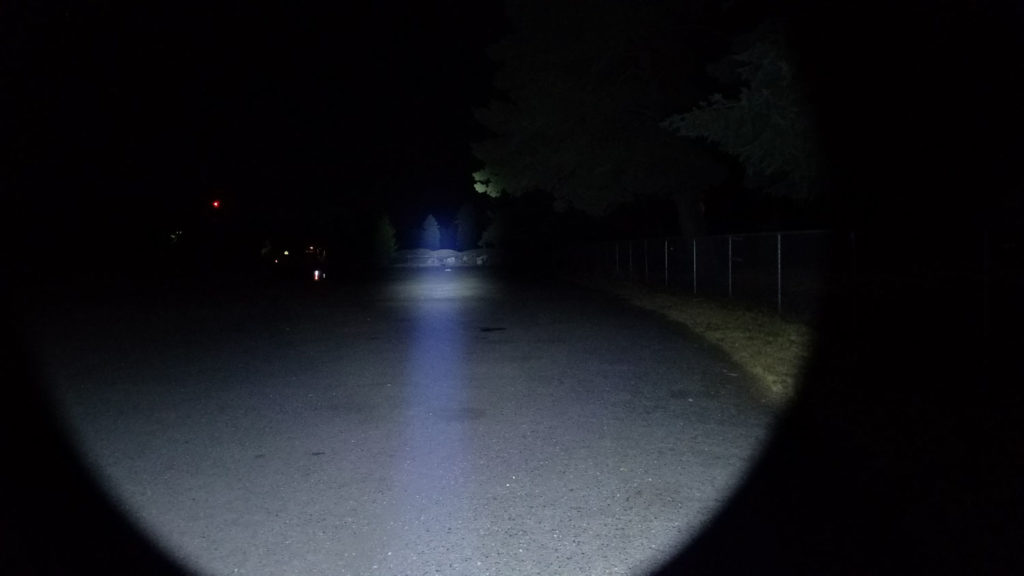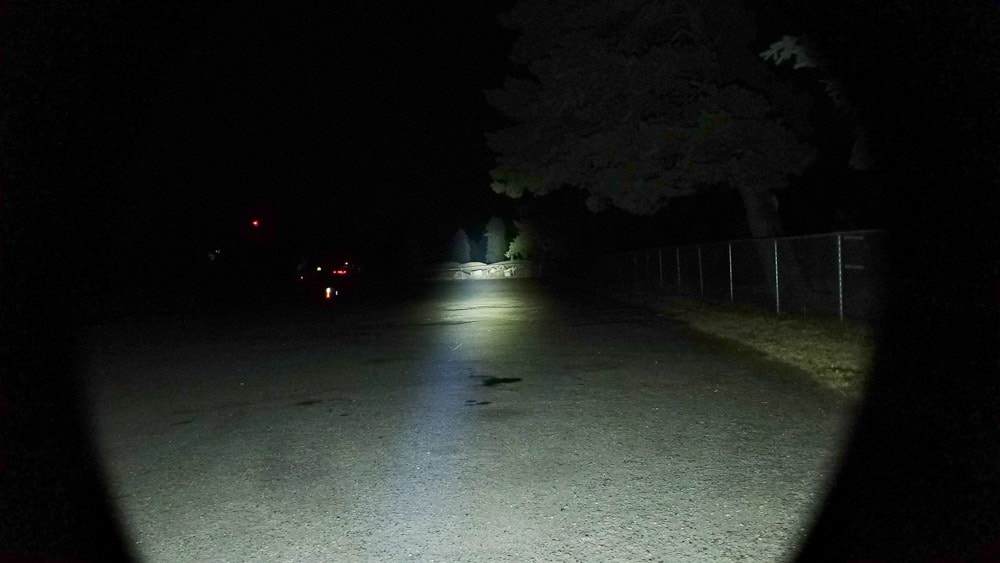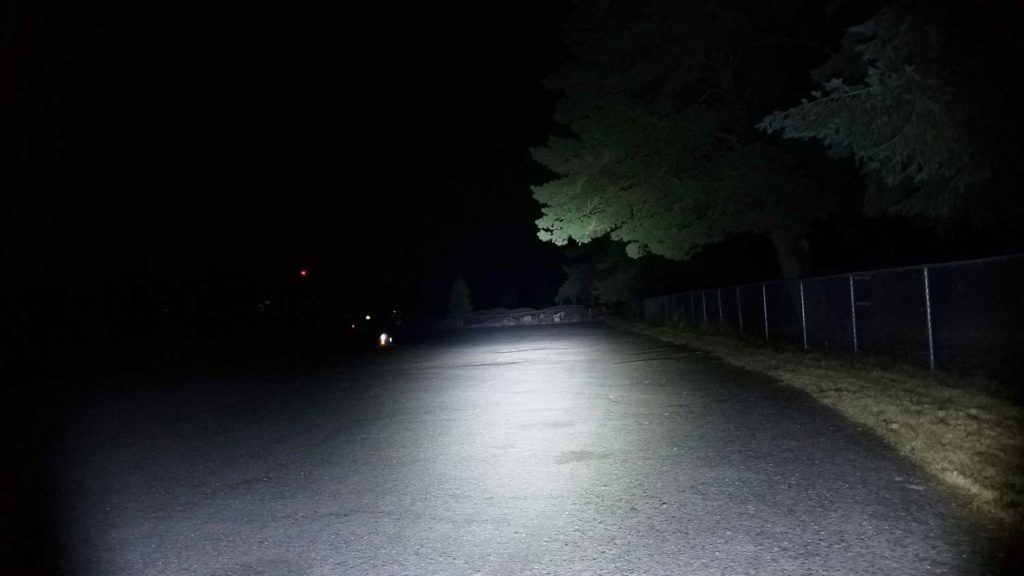1lumen selects and reviews products personally. We may earn affiliate commissions through our links, which help support our testing.
Convoy L21B review
Convoy L21B specifications
| Brand/model | Convoy L21B |
|---|---|
| LED | Luminus SFT40-W |
| Lumens | 2,000 lm |
| Beam intensity | 395,000 cd |
| Battery config. | 1*21700 |
| Material | Aluminum |
| Modes | Many, runs Biscotti |
| Blinkies | Strobe, SOS, Bike Flasher |
| Reflector | Smooth |
| Waterproof | N/A |
| Review date | September 2021 |
Introduction:
If you’ve been following the flashlight scene for any amount of time, you’ve probably heard the name Convoy dropped. No, no, not the 1978 flick starring a very young Kris Kristofferson, and no, not the country song of the same name by C.W. McCall. I’m talking about everyone’s favorite Chinese flashlight brand!
Many enthusiasts’ first lights were Convoys, and for good reason. They’re simple to use, easy to repair and mod, well-built, and good performers. More importantly, they’re extremely affordable. You could postulate that Convoys are like the Ford Model T’s of the flashlight world, bringing bright, serviceable flashlights to the masses for cheap. Simon Mao (the fellow behind the name), has brought us some memorable lights over the years, but they perpetually seemed to be 1 or 2 steps behind the competition, lacking USB C charging, e-switches, FET drivers, or fancy UI’s. If you wanted those, you bought an Astrolux, Sofirn, Lumintop, Emisar, etc. Well, Simon was listening and really refreshed his lineup over the last 2 years, releasing lights with new UI’s, updated drivers, and our favorite emitters including the SBT90.2. Aside from the 90.2, the one we were most excited about was the Luminus SFT40-W. Well, Simon obliged, not only releasing the emitter, but stuck it in a new host. Today I’ll be taking a look at that new host with the SFT40-W, the L21B. This is a slimmed-down, lightened, and more streamlined L21A. Specs say more throw than the Boost HX and almost double the Lumens? Should be good!
Package quality.
Okay, we all know Convoy doesn’t invest heavily in packaging. I mean, you do get a box…with a light in it. Well, there is a lanyard in there, and the light was wrapped in bubble wrap. That’s pretty much it. The box did what boxes do best and the light was undamaged, so no complaints.
- Convoy L21B
- Lanyard (attached)
Maybe I’m used to being showered with accessories, but I get it. Those cost money, and Convoy is about as budget as it gets without digressing into the Chinesium junk floating around out there. The lanyard…well, it works, but is the cheap non-adjustable type. I’d at least like to see some o-rings (wear items) in there, but alas, beggars can’t be choosers, right? On we go.
Flashlight in use
The L21B (L=large) is a single-cell, shortened, slightly smaller version of the 2-cell L2. It’s about the same size as an Astrolux FT03 with a roughly-60 mm reflector. The original version was heavily finned for heat sinking and pretty bulky and heavy. While it’s dimensionally-similar to the L21A, the L21B has been completely re-designed. Not only that, but apparently it’s been watching old Richard Simmons workout tapes and has gone on a diet and shaken the butter off those buns.
The original L21A weighed 385 grams without a battery vs. 215 for the L21B. In addition, the L21A’s plethora of heat sinking has been buzzed down, blended into a smooth sloping head design with the minimalist heatsink fins moved to the rear of the head (where the majority of the heat goes). I really liked handling this light. The 21700-size tube feels great in the hand, and the texturing on the tube combined with the finish makes a solid gripping surface. It’s front-heavy, but well-balanced and easy to point and handle. It’s not going into your pants pocket, but will fit in a jacket pocket or cargo pocket. The light retains the L21A rear reverse clicky switch on the taicap (reverse=press and release for on), and it’s a nice switch with firm action and positive feedback without being obnoxiously ‘clicky.’ Tail standing is no problem thanks to a flat base, but it’s a bit wobbly. There are 2 nicely-sized holes in the tailcap for attaching the lanyard also.
Build Quality, and Warranty
One common denominator with Convoys is the value. The L21B, depending on the emitter, goes for around $35-$40 US, which is a great deal for what you get: Solid build quality, ultra-nice machining with no tool marks or burrs, chips, or eccentricities. The parts fit together great, with even edges and no gaps or sharp edges. The finish? One of my favorites. It’s a nice matte type III HA anodizing, very nicely done too, with no blemishes, thin spots, or bare areas.
Simon must think the g-word is a dirty word, since nothing is glued, Loctited, or gooped on his lights. This is a recurring theme for every Convoy light I’ve modded. It’s not just being able to remove the bezel and change an o-ring, but you can completely take the L21B apart. No special tools needed. The bezel unscrews easily, and the driver, tailcap PCB, switch, and MCPCB are all held in with screws or retaining rings. The soldering is nicely done also, and Simon gets 5 gold stars for catering to enthusiasts, or just those who can’t leave an otherwise nicely-functioning light as-is (like me). Simon also stocks parts to fix your L21B if you do fry something. Need a reflector? Lens? Yep? Driver? Got you covered there also.
The threads on the battery tube are very nicely done, square cut, and really stout. The threads for the bezel are finer and triangular cut. They were very smooth, and the battery tube threads were nicely lubed. The rear tube threads are fully anodized for manual lock-out, but the fronts are bare. No complaints with the threads. The springs are gold-plated and on the thin side it seems, but this light doesn’t pull 10+ amps, so they’re not needed. Unlike most Convoys, the tailcap spring isn’t bypassed, and the driver has a 3.5 mm diameter brass post for the positive contact. A tailspring bypass probably won’t help much since this is a current regulated diver. More on that later.
Convoy doesn’t imply a warranty per-se, but if you have a problem with your light, you can contact Convoy and Simon will send you the part or parts you need to repair the light. His customer service is legendary, so no worries if something goes wonky with your Convoy.
LED, Lens, Bezel, and Reflector
The original L21A came with a variety of emitters, from the XP-L to the Boost HX, and this is carried on in the L21B, with the addition of a new emitter that LED nerds like me get giggly about, the Luminus SFT40-W. This is Luminus’ new 5050-size LED, released several months ago to consumers in the Cyansky K3 tactical thrower. It’s a domeless emitter and features a unique 4 bond wire design with lots of throw with high output. For the record, this is not a domeless SST40, it’s an entirely new design and can be driven much harder (10+ amps is no problem).
It really is the best of both worlds for domeless emitters. It’s offered in 6500K only (for now), but I’m not too bothered by that these days since CW is great for throwers. The LED sits behind a 60 mm SMO reflector topped with a decently-thick AR (very purple) coated mineral glass lens. The bezel is aluminum (for weight savings probably), and the lens is set back about 2.5 mm to protect it from drops. The beam is about what you expect, but it’s more versatile than an all-out thrower with generous spill with a good-sized, perfectly-focused hotspot. You still probably wouldn’t shelve your EDC light for this, but as a secondary light for bumping around, hunting, or surveying, it’s perfect out to 500+ meters. It throws like crazy! Reminds me of a Boost HX light, but with twice the Lumens. There’s no angular tint shift, no anomalies, or rings in the beam either. Very nicely done!
Dimensions and size comparison
- Length: 17.05 cm / 6.71 inches
- Head diameter: 6.2 cm / 2.44 inches
- Body diameter: 2.6 cm / 1.02 inches
Weight:
- Without cells: 215 grams / 7.58 oz.
- With Epoch 50G 21700: 284 grams / 10.1 oz.
Flashlight size comparison
I compared the L21B to some other throwers of similar size (and some not).
Group 1 left to right: Acebeam L18, Acebeam L19, Convoy L21B, Nightwatch NI03 Valkyrie.
Group 2 left to right: Thorfire C8, Astrolux FT02S, Convoy L21B, Astrolux EC03.
Group 3 left to right: Convoy L21B, WildTrail WT90.
Driver & User Interface:
The driver is actually pretty slick for the price tag. It’s a 22 mm 8-amp buck driver designed for the Osram Boost HX-powered lights, but has been conscripted to drive the SFT-40-W. It’s a good fit, since it’s not being driven too hard, and does well in a host this size. For the UI, Convoy is the lone ranger, so to speak, when it comes to advanced UI’s, namely, the lack thereof. Nary a truly advanced UI has ever graced a Convoy driver. Anduril? Nope. Narsil? Nein. Crescendo? Nada. Biscotti? Yes! That’s right, this driver features the old favorite Biscotti UI.
Available modes: The 12-mode driver has, well, 12 mode sets of preconfigured brightness settings, sort of like NarsilM’s mode sets. By default, the 1st of the 12 modes was selected, but the other modes are configured as follows:
To enter the configuration mode, tap the switch 20 times. You can select the mode group set Option 1, or Option 2 for mode memory enable/disable (it’s enabled by default). The light will blink once, buzz then flash for Option 1 at which point you select this mode, or wait for Option 2, which is 2 flashes, buzz+flash for mode memory on/off.
- Group 1 (default): 0.1%, 1%, 10%, 35%, 100%, strobe, bike strobe, batt check
- Group 2: Same as group 1, but without the blinkies
- Group 3: Group 2 in reverse
- Group 4: 1%, 20%, 100%, strobe, bike flasher, batt check, S.O.S.
- Group 5: 1%, 20%, 100%
- Group 6: Group 5 in reverse
- Group 7: 0.1%, 1%, 10%, 50%, strobe, bike flasher, batt check, S.O.S.
- Group 8: Group 7 without the blinkies
- Group 9: Group 8 in reverse
- Group 10: 1%, 10%, 35%, 100%
- Group 11: 100%, 20%, strobe
- Group 12: 100%
From OFF:
- Press and Hold: N/A
- Single click: Turns on in last mode (if memory enabled)
- Double click: N/A
- Triple click: N/A
From ON:
- Press and Hold: N/A
- Single short press: Changes to next mode
- Single click: Turns off
- Double click: N/A
- Triple click: N/A
Mode memory:
- Yes, enabled by default, but can be disabled
Shortcuts:
- Nope
Low voltage warning:
- Yes, at 2.8 volts the light will turn off
Strobe/blinkies
- Yes, depending on the mode set, you get a variable tactical strobe, bike flasher, battery check. It blinks up to 5 times on a full battery, so I presume 5 blinks= 100% battery, 4 blinks= 80%, 3 blinks= 60%, 2 blinks= 40%, 1 blink= 20% or less
Lock-out mode:
- Nope. Manual lockout by unscrewing the tailcap 1/5th turn
PWM
- None
Additional info on the UI:
I first encountered this UI back in late 2019 when Simon released it on the “5 amp constant current driver” with the 12 group firmware. For a somewhat-advanced clicky UI, it works fine. I like the selection of configurable modes since this driver would work in a lot of applications (thrower, EDC, worklight, etc.). That said, the mode-spacing is a little odd: 1% to 10% is a big gain, and 35% to 100% is also big. A word of warning if you want to swap out the L21B’s reverse clicky for a forward-clicky: Don’t. It will work, but it’s an absolute hassle to program and set mode groups. You were warned.
It does have Convoy’s version of ATR, set at 50 or 55 C for regulation. Yep, I’ll test that. I’d love to see a more advanced UI gracing Convoy’s otherwise amazing clicky ights (please, please get Crescendo for us Simon!), but alas, for now this is what we have. Now, don’t get me wrong, I prefer simple UI’s, and I’m glad Convoy is slow to release Anduril-equipped lights for those who don’t want to mess with calibrating and all those superfluous features. These are great lights for novices and beginners!
Batteries & Charging
The Convoy L21B takes any battery you want as long as they’re 21700’s (or maybe long 18650’s). Flat tops and button tops work fine, but longer 21700s like protected or with charging probably won’t fit. My 78 mm long Acebeam 21700’s with built-in charging did not fit, but my button top Epoch 50G 21700’s did. This light doesn’t need a high drain cell (10 amps is fine), so a Samsung 50E, 50G, Molicel M50, Lishen LR-series, etc. will work fine in this light. I tried a Samsung 30T in it, and I didn’t see an appreciable difference in the input current (makes sense, current-limited driver). There’s no onboard charging, so you’ll need a 21700-capable charger. It’s an added cost to the purchase of the light if you don’t have one, but Convoy sells them separately for fairly cheap.
Performance
Lumen measurements (for each mode)
I measured Lumens using my home made integration tube made from a 4 inch to 3 inch closet elbow, two 3 inch street 90s and an end cap. I’m using a Digi-Sense 20250-00 data logging lux meter. It’s calibrated with several lights of known output. Tests were conducted using a fully charged Samsung 30T and I used the default mode group. Amps were measured using my Radio Shack TRMS multimeter with short 16 gauge wires inserted directly in the meter for currents up to 5 amps, and my FY219 clamp meter with a piece of 12 gauge wire in a loop for over 5 amps.
| Mode | Amps at start | Specs | @ start | @30 sec | @10min |
| 0.1% | 39 mA | ? | 6.72 | 6.72 | – |
| 1% | 79 mA | ? | 35.2 | 35.2 | – |
| 10% | 564 mA | ? | 319 | 319 | 301 |
| 35% | 2.17 A | ? | 957 | 957 | 893 |
| 100% | 7.91 A | 2000 lm | 2088 lm | 2030 lm | 899 |
Parasitic drain:
- None, it’s a mechanical switch
Runtime graph
Runtime tests were conducted using the integration tube with the Digi-Sense 20250-00 data logging lux meter calibrated using several lights of known output. I used an Epoch-branded (rewrapped Samsung 50G) 5000 mAh 21700 cell for the test. Convoy doesn’t list runtimes for their lights. Never has.
The 100% setting started at 2030 Lumens and held that for 10 seconds before stepping down to 2000 Lumens, where it stayed until the 40 second mark, then another indiscernible step down. This continued for the next 9 minutes, but the output was over 1500 Lumens for over 5 minutes. Impressive. I was expecting lots of heat, but even at 60 seconds, the head was 50 C. It didn’t peak until 20 minutes in, when the output was 899 Lumens, which it held for almost an hour. The output didn’t drop below 800 Lumens until the 1 hour 39 minute mark when the output dropped to under 700 Lumens. There was a mysterious pause at the 1 hour 41 minute mark for 50 seconds, which was repeated on all the tests. Strange. I don’t know if this is an LVP notifier or not? 13 minutes later LVP really did hit and the light shut off abruptly at 1 hour 54 minutes.
35% started at 922 Lumens and in typical buck driver fashion, didn’t change much for the entirety of the 2 hour 9 minute runtime with only gradual step downs. I noticed the same odd pause in the output at the 2 hour 2 minute mark that lasted for 2 minutes before picking back up gradually to 345 Lumens. This was followed by more gradual throttling down to 232 Lumens before the abrupt shut down. Heat wasn’t really an issue here either, with the highest temp coming at 1 hour in at 54 C. The battery tube was still cool enough to handle briefly.
10% was pretty predictable (read: boring). From the 304 Lumen start, there was only a slight deviation of +/- 6 Lumens over the next 7 hours and 35 minutes. There was some final throttling at the 7 hour 44 minute mark, and gradual step down until the abrupt LVP shut down at 7 hours 47 minutes. Note the shutdown reading is the same for all modes: 232 Lumens when the plug is pulled. I never saw over 36 C throughout the test.
Takeaways? A nicely regulated buck driver on a single cell light is awesome, and I’m glad Convoy paired it with the SFT40-W. It’s a great combination and nearly hits the sweet spot of sustainability and output. The thermal regulation worked fine, and the light is still usable even when the head is 54 C. The LVP cutoff is a little unnerving though since you don’t get much of a warning. Maybe a blip or two then off. The light is also not functional after the tests and won’t turn on until you replace the battery, so keep spares on hand. I’ll take it though just to get this gem of a driver. The fact the light holds almost 900 Lumens at 100% for as long as it does is awesome.
Throw numbers:
Throw was measured at 10 meters outdoors using the Uni-t UT383S lux meter. I used a Samsung 30T 21700 battery for the test. Readings were recorded at 30 seconds.
| Mode | Specs | Candela measured | Meters |
| 0.1% | ? | 800 cd | 57 |
| 1% | ? | 5500 cd | 148 |
| 10% | ? | 54,500 cd | 467 |
| 35% | ? | 167.3 kcd | 818 |
| 100% | 395 kcd | 283.2 kcd (340.8 kcd at turn on) | 1,064 (1,167 at turn on) |
I didn’t quite get 395 kcd and 1258 meters spec’d, but I measured at 10 meters. Those figures were probably from a 5 meter test. Still, over 1000 meters (1100 at turn on) out of a sub-60 mm reflector is fantastic and proves the SFT-40-W is all that and a bag of chips! Remember, this is at a hair over 2000 Lumens. No Boost HL or HX could manage that. Only the SBT90.2 does better at these outputs.
Beamshots
I tested the L21B against some other throwers: The Acebeam L18 (confirmed to throw 1000 m), Acebeam L19 (throws 1300+ meters), SFT40-W equipped Cyansky K3 (almost 700 meters), a Nightwatch NI03 (throws over 700 meters), and a WildTrail WT90 (throws over 1700 meters).
The water tower is 90 meters away
The fence is 95 meters away
Disclaimer: This flashlight was sent to me for review at no cost by Simon (Convoy). I have not been paid to review, nor have I been holding back on problems or defects.
Final Verdict
Pros
- Lightweight
- Great build quality and finish
- Easily disassembled
- Throws awesome with high output
- Nice, clean beam with good spill
- Consistent output and sustainability
- Great value
- Buck driver
Cons
- No onboard charging like competitors
Explanation on star ratings:
1: Avoid: my phone flashlight would be a better choice – 2: Poor: significant defect or issues, much better options available at the same price – 3: Average: some defects or issues – 4: Good: recommended (minor issues) – 5: Great: highly recommended
5 stars: ★★★★★
I first heard about Convoy in my second week of this hobby, exploring CPF and BLF for the latest and greatest, what-to-buy, and what have you. Back then, although they were nice, solid lights, unless you wanted an S2+, C8+, or L6 host for modding, hardcore enthusiasts didn’t really gravitate towards Convoy for the latest and greatest. However, 2 years on, and that’s all changed because Convoy is fielding lights featuring USB type C charging, 21700 support, e-switches, ramping UI’s like the M21D, L7, 3×21, M21E. Moreover, you can get your ‘old’ favorites with modern LEDs like the SBT90.2, SST70, SFT40-W, and GT FC40. This is all good stuff and the redesigned L21B fits into this scheme.
For about $40 US, you get a compact host, a very useful and uncluttered beam, slick, lightweight design, constant-current buck driver, and a somewhat-advanced UI in Biscotti. I really enjoy the L21B, and even though it’s not super-special, this is kind of an important flashlight for Convoy since it proves you can build a 1000+ meter thrower that makes 2000 Lumens without an FET driver. Nobody has done that before that I know of so major props to Convoy. If I had to pick on an otherwise great light, I think onboard charging would be nice, as would a UI like Crescendo for some hardcore clicky ramping action, but who knows? Maybe it’s in the works? A home-run for Convoy and 5 stars for the Convoy L21B.
Convoy L21B For Sale
But at Convoy store at Aliexpress
1lumen selects and reviews products personally. We may earn affiliate commissions through our links, which help support our testing.
